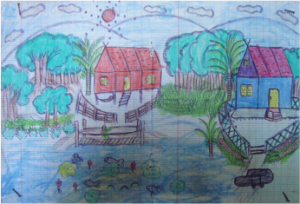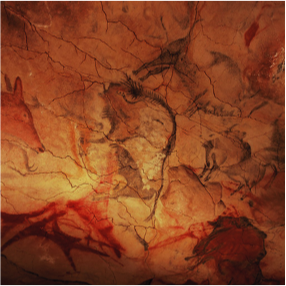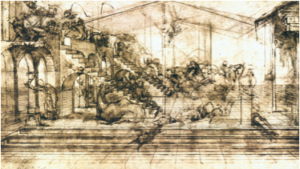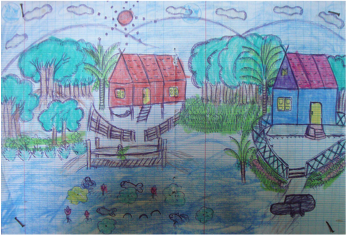 Jean Gebser’s cultural home base was the world of art. He was a personal friend of Pablo Picasso’s, and examples culled from art history dot the landscape of his The Ever-Present Origin, illustrating almost every significant point he makes. It’s not surprising that his master interpretive lens, perspective, should itself derive from the domain of art.
Jean Gebser’s cultural home base was the world of art. He was a personal friend of Pablo Picasso’s, and examples culled from art history dot the landscape of his The Ever-Present Origin, illustrating almost every significant point he makes. It’s not surprising that his master interpretive lens, perspective, should itself derive from the domain of art.
Yes, perspective. Just like you learned in elementary school art. When you first began drawing pictures, probably as a preschooler, Mommy and Daddy and your big sister were always bigger, no matter where they appeared in your picture, because that’s what they were! Then someone taught you about foreground and background, and you learned how to make things at the back of the picture smaller to show that they were farther away. You learned to turn your house at a slight angle on the page so that you could show two sides of it at once. You may or may not have consciously realized that you were learning how to proportion the various bits and pieces in relation to a hypothetical point on the horizon. But your drawings got more orderly, and they began to convey a sense of depth.
That’s exactly what we’re talking about here. Perspective. But now applied as an organizing principle for the field of consciousness.
According to Gebser, the five structures of consciousness we met up with in my November 18, 2020 post Stages Versus Structures: Exploring Jean Gebser, Lesson I (you will find the link is at the bottom of this post)—archaic, magic, mythic, mental, and integral—can be grouped into three larger categories, or three worlds, as he calls them: unperspectival, perspectival, and aperspectival. While the nomenclature may at first feel intimidating, it’s actually quite easy to master if you keep your elementary school art days in mind. Unperspectival is how you drew before you learned about foreground and background, when everything was all just jumbled onto the drawing sheet. Perspectival is the drawing sheet once you’ve learned to arrange it in relationship to that hypothetical point on the horizon. And aperspectival is what ensues once you’ve learned to convey several perspectives simultaneously, as in some of Picasso’s surrealistic artwork where he simultaneously shows you the front side and back side of a person. A heads up: in Gebser the prefix “a” always conveys the meaning of “free from.” Thus an aperspectival view is one that is free from captivity to a single central point of reference.
The Unperspectival World embraces the archaic, magic, and mythic structures.
The Perspectival World hosts the mental structure.
The Aperspectival World is the still-emerging integral structure.
Each of these three perspectives is properly called a world because it comprises an entire gestalt, an entire womb of meaning in which we live and move and make our connections. Each has its own distinctive fragrance, ambience, tincture. Each is an authentic pathway of participation, an authentic mode of encountering the cosmos, God, and our own selfhood. Each has its brilliant strengths and its glaring weaknesses. Compositely, they evoke “the width and length and height and depth” of our collective human journey into consciousness.
I am aware that I am walking the razor’s edge as I choose my words here, trying to escape the gravitational field of perspectival consciousness that would lock this all back into the evolutionary timeline. It is true, of course, that these three worlds broadly demarcate the three major epochs of Western human cultural history: ancient, medieval, and modern. But it’s always been a bit dicey to try to hold these timelines too tightly or to limit structures of consciousness to specific historical eras. We have stunning exemplars of the mental structure breaking through in ancient Greece and Israel, and the mythic still lives among us today in much of the American heartlands. Gebser’s model deftly sidesteps these all-too familiar cul de sacs by reminding us that the “worlds”—and the structures they encompass—are phenomenological, not developmental. While they appear to join the flow of linear time at specific entry points, they have in fact always been present and must continue to be present, for they are part of the ontology of the Whole.
Gebser’s visually oriented presentation allows him to make one additional very important point. From a visual standpoint, perspective is really a matter of dimensionality, and dimensionality is in turn a function of degree of separation. Gebser builds on this insight to draw powerful correlations between the emergence of perspective within the structures of consciousness and the emergence of the egoic—i.e., individual—selfhood so foundational to our modern self-understanding.
In the unperspectival world everything exists in guileless immediacy (remember preschooler art?). There is relatively little separation between viewer and viewed, the external world mirroring a self-structure that is still fluid and permeable. This is the world of “original participation” (as philosopher Owen Barfield once famously described it) where the cosmos is at its most numinous and communicative, and the sense of belonging is as oceanic as the sea itself.
 As we enter the perspectival world, the double-edged sword begins to fall. The same growing capacity for abstraction that makes possible the perception of proportion and depth also—by the same measure—increases our sense of separation. We stand more on the outside, our attention fixed on that hypothetical point on the horizon which organizes our canvas and maintains the illusion of depth within a flat plane. Order is maintained, but at the cost of a necessary distancing and a strict adherence to the artifice that makes the illusion possible in the first place. Deception enters riding on the back of that abstractive power, as “original participation” gives way to a growing sense of dislocation and exile. That is essentially our modern world: “oscillating,” writes Jeremy Johnson in Seeing Through the World (pg. 58) “between a powerlessness to control the forces unleashed by the perspectival world on the one hand, and a total self-intoxicating power on the other”—in a word, “between anxiety and delight.”
As we enter the perspectival world, the double-edged sword begins to fall. The same growing capacity for abstraction that makes possible the perception of proportion and depth also—by the same measure—increases our sense of separation. We stand more on the outside, our attention fixed on that hypothetical point on the horizon which organizes our canvas and maintains the illusion of depth within a flat plane. Order is maintained, but at the cost of a necessary distancing and a strict adherence to the artifice that makes the illusion possible in the first place. Deception enters riding on the back of that abstractive power, as “original participation” gives way to a growing sense of dislocation and exile. That is essentially our modern world: “oscillating,” writes Jeremy Johnson in Seeing Through the World (pg. 58) “between a powerlessness to control the forces unleashed by the perspectival world on the one hand, and a total self-intoxicating power on the other”—in a word, “between anxiety and delight.”
It is my own observation here (rather than either Jeremy’s or Gebser’s) that the perspectival contains an inherently deceptive aspect since it is intentionally creating a sleight of hand—the illusion of three-dimensionality within a two-dimensional plane. But if I have not wandered too far off the mark, the observation gives me some strong additional leverage for emphasizing why resolutions to the perspectival crisis can never emerge from within the perspectival structure itself, and why the much-hyped “integral emergence” cannot simply be a new, improved version of our old mental habits—not even a vastly increased “paradox tolerance.” We need to get out of Flatland altogether.
For me, that is what aperspectival is essentially all about. It is an authentic transposition of consciousness from a two-dimensional plane to a sphere. Within that sphere, inner and outer world come back together again, and a sense of authentic belongingness returns. Numinosity returns as well: the felt-sense of a cosmos directly infused with the vivifying presence of Origin. Selfhood once again becomes fluid and interpenetrating even as presence becomes more centered and intensified.
The perspectival is at best a foreshadowing and at worst a mental simulacrum of authentic aperspectival three-dimensionality. The real deal can indeed be attained; in fact, it is now breaking in upon us whether we like it or not! But the cost of admission is not cheap: it entails the overhaul not only of our fundamental attitudes, but of our entire neurophysiology of perception.
 I hope to circle back to this point in due course. For now, the most important thing to keep in mind is that in the Gebserian system perspective is not simply a point of view; it is a completely different world of seeing, unfolding according to its own protocols: its own core values and ways of making connections. To truly take in another’s perspective is not simply to take in another’s “position” and arrange the pieces dialectically on a mental chessboard. Rather, it is profoundly to take in another world and allow that world to touch our hearts and wash over us deeply until it, too, becomes our own. It is to listen in a whole new dimension. And I believe Gebser would argue that this dimension only truly opens up with the inbreaking of the aperspectival structure.
I hope to circle back to this point in due course. For now, the most important thing to keep in mind is that in the Gebserian system perspective is not simply a point of view; it is a completely different world of seeing, unfolding according to its own protocols: its own core values and ways of making connections. To truly take in another’s perspective is not simply to take in another’s “position” and arrange the pieces dialectically on a mental chessboard. Rather, it is profoundly to take in another world and allow that world to touch our hearts and wash over us deeply until it, too, becomes our own. It is to listen in a whole new dimension. And I believe Gebser would argue that this dimension only truly opens up with the inbreaking of the aperspectival structure.
A Note from Northeast Wisdom/Wisdom Waypoints:
We appreciate your comments, please share your reflections in the Comments section below.
Jeremy Johnson’s book: Seeing Through the World: Jean Gebser and Integral Consciousness, is available from the publisher, here at Revelore Press.



Who can help to explain better in words Gebser’s view of blindness to a sense of space before the 1400s even though yes no one painted perspective until the Renaissance? Surely people understood why camels receded into the distance or children enlarged as they ran toward you? They built massive ships and measured speed which can’t be done without knowing about time. I can understand the sense of being lost in a collective or a myth in ancient time, but it’s hard to imagine people not being aware of space. We allegedly per Gebser only achieved a sense of time in the modern era, but surely the ancients, who invented sun dials, saw the sun passing through time, moment by moment, from East to West in the course of a day, or their children and plants growing through time? Who can explain this alleged shift according to Gebser in consciousness more clearly please?
They didn’t have to concept of a single vanishing point. See Giotto, which has multiple vanishing points. And Gebser didn’t know the Chinese had developed their own “perspective” (axonometry). His explanation of Cubism is contrived. See https://jankrikke2020.medium.com/why-the-world-relies-on-a-chinese-perspective-cf3122caf67f
I’m rather leaning to enjoying development within the structures. This growth capacity seems to fill up every structure available completely, eventually. And then what? Will a new structure emerge like a mysterious gift…a gift for human life anyway. In which case, we can then happily get busy and explore, learn and develop until that is full too and maybe go back and fill in some corners that appear in other structures (I’m always finding lots of room in the magic box). I have a feeling that a structure available to us might look like an empty, even invisible structure. Development within it will never fill it and it will seem to remain empty yet it seems be a structure! This might end the necessity for any sort of flatland sense, at least in that location. So far, I’ve been able to find…the holy indwelling spirit in every structure and love them ALL because of that. That doesn’t make them less of a challenge with lots of the failures particular to each structure. The spirit is just so encouraging. What do you think? Is an empty structure (form) still a structure? Can we fill it with silence and peace maybe? And then what….from what I’ve seen of this universe, structures are abundant and perhaps infinite forms of consciousness tended by love.
This resonates with my current experience of moving between realities with totally different ways of being and interacting… the reality within the dream and the dissolving presence of the ‘me’ within the wakeful state.
This is difficult material, at least for me. What comes to mind in reading is to get outside the box. We are in a perspective and it’s important to not be of it.
Oh – this is all feels so important! I long to get out of Flatland; to help us all to ‘see’ and live beyond this view. For now I’ll do my best to return as often as I am able to that place of ‘paradox tolerance’, trusting that this new aperspectival view is an inevitable and future gift for us all. And hoping we can help to usher it in in time.
I’m grateful for these teachings. I’ve only been able to share comfortably Wilber’s brilliant insights with my liberal friends, hoping we would ‘grow up’, and it always left me feeling embarrassed and disloyal to my conservative friends, many who are far more intelligent and mature than I ever will be in this lifetime.
Thank you, Cynthia.
Beautiful! A full Blessing. Thank you.